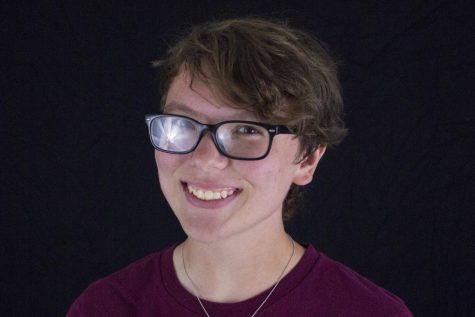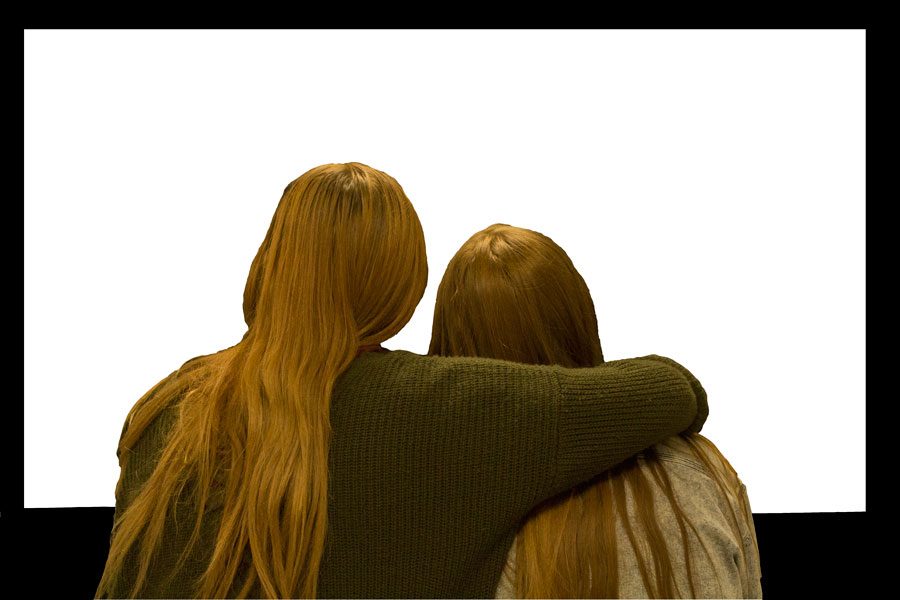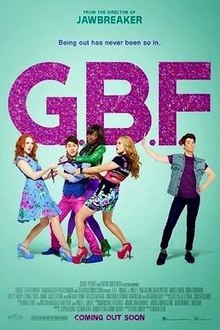Becoming normal
The movie industry has ignored LGBT people for too long
Two girls attend a movie. Movies do not tend to cater to viewers who are not straight. The gallery offers a collection of good books, movies, and TV shows featuring non-straight characters.
My friends’ laughter began to fade with the dimming of the lights around us. We all settled back
into our seats in anticipation for our movie as the previews began. They were the same as they always were: trailer after trailer for superhero movies (in which the leading man falls in love with the beautiful girl), horror movies (starring your prototypical mother-father-child family), rom-coms (an unbelievably attractive woman leaping into the arms of her unbelievably attractive male love interest). But in the midst of all these familiar stories, one came on that was different from the rest. Watching the beginning, seeing a teenage boy and girl talking to each other, I waited for yet another plot about this boy falling for this girl, but I was shocked when the main character’s voice came over the speakers, loud and clear, saying two words that I felt jolt through my body:
“I’m gay.”
I looked around at my friends. It was obvious none of them had the same reaction as I had. For them, this was just another trailer, just another movie. But to me, this movie was so important that just the trailer – and it wasn’t even a particularly great trailer – nearly brought me to tears.
All because of a mainstream movie about an openly gay character – about someone like me.
To my friends – and to most straight people – this is no big deal. And sure, it is just a movie. But gay people, we just don’t get movies about us. Any watcher of movies – or watcher of TV shows or reader of books, for that matter – is used to straight romance; the ma
n will always fall in love with the woman, regardless of genre, regardless of plot, regardless of whether or not they end up together. Movies about straight people falling in love are anticipated; my friends and most of the other people in the theater that day were used to seeing people like themselves shown on the big screen. They saw their own lives and relationships portrayed in every movie they watched, in every other trailer that played that day, in the movie that showed afterwards.
I, on the other hand, didn’t. I saw people who are similar to me, yes, but it isn’t quite the same. Sure, movies about straight romance are fine – I’m definitely a sucker for any kind of cheesy rom-com – but being gay is lonely enough as is without the added bonus of not being able to see lives like mine portrayed anywhere, perpetuating an inherent sort of loneliness I feel as a gay person, as if I don’t quite fit in anywhere, in the real world or in the movie world.
And this is why this issue is important: it’s not really about the movies. It’s about the years of my life I spent feeling left out, like there was something wrong with me, because who I was wasn’t normalized. It’s about the years I spent in middle school dating boys despite never really wanting to because that was what I was supposed to do; that was what everyone else did; that was what every character in the movies I saw, in the books I read, did.
I never had anyone to tell me what I was feeling was okay; I didn’t even have the chance to decipher what I was feeling because I had nothing to tell me what it was. So it became wrong in my mind because people like me didn’t make it to the big screen; they didn’t get books written about them or the chance to star in movies. People like me weren’t mainstream, weren’t normal. We were sexualized or villainized, but never ever normalized.
Inevitably, I will bemoan this one-sided industry to my friends, complaining that I’m bored of straight romances, lauding whatever little scrap of gay media – whether it be book, movie, or TV show – I had found recently and actually liked, when someone will roll their eyes, giving me that look I have come to know so well to mean I’m overreacting.
“Doesn’t Netflix have an LGBT section?” they’ll ask. “I just saw a show with a gay person in it. Didn’t that movie about gay people just win an Oscar?”
Or my personal favorite: “Not everything has to be gay, you know.”
I don’t know if you’ve ever actually scrolled through Netflix’s LGBT section, but it’s pathetic. One tiny collection of foreign films and caricatures does not equivocate the hundred other sections Netflix and every other streaming site has catering to straight people. Giving us a scrap of bread as you tuck into your feast does not mean we are not hungry; we’re still starving. Making a few tragic stories about how hard it is to be gay is not enough. Shoving a single line implying the villain’s sidekick is gay into a Disney remake is not enough. Making one or two overly-artistic movies aimed towards adults is not enough. I want cheesy high school movies about lesbians, crime shows where the lead detective is married to a man, books that actually capture what it’s like to be gay. I want to be able to scroll through a section on Netflix on a night when I’m lonely, pick a movie, and feel less alone, not more.
I want to go to the movie theater and be so used to gay characters appearing in movies that I no longer get chills down my spine from hearing those two words said on-screen.
I want kids who might not be sure they’re straight to grow up feeling normal.
I want to feel normal.
This movie, “Love, Simon,” is a step in the right direction. Every piece of gay media is a step in the right direction. But it’s not enough until we’re allowed to feel just as commonplace as every other person in the theater watching that movie with us that day. When I can casually go out to see a movie and see someone like myself on the big screen, when I can pick a movie off Netflix at random and not feel left out, when gay people become as commonplace onscreen as we are in the world around us, then it will be enough.
Your donation will support the student journalists of Francis Howell Central High School. Your contribution will allow us to purchase equipment and cover our annual website hosting costs. FHCToday.com and our subsequent publications are dedicated to the students by the students. We hope you consider donating to allow us to continue our mission of a connected and well-informed student body.





